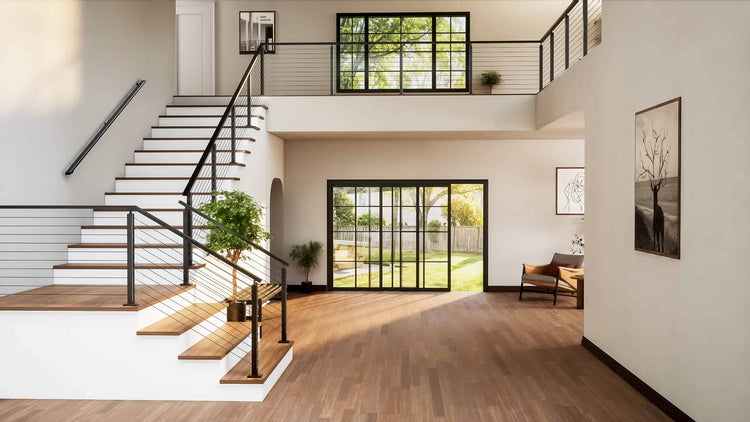How to Choose Your Cable Railing System: A Guide for Canadian Homeowners

Introduction to Cable Railing Systems
Cable railing systems are increasingly becoming a staple in Canadian homes, renowned for their sleek design and robustness. As a perfect blend of functionality and style, they provide an unobstructed view and a modern touch to any space. As well as being aesthetically pleasing, cable railings offer several practical benefits, especially in the Canadian climate. Their minimalist design allows for unobstructed views, while the materials used, typically stainless steel or aluminium, provide durability in harsh weather conditions. In addition, their sleek lines can complement both modern and traditional architecture.
This article aims to guide Canadian homeowners through the process of selecting the best cable railing system, focusing on design, material, installation, and compliance with local regulations.

Understanding the Basics of Cable Railing Systems
A cable railing system typically consists of horizontal or vertical cables. Essential components include posts, handrails,cables, terminals,and the accessories. Understanding these basics is crucial for homeowners to make informed decisions about the type, style, and functionality of the railing system they wish to install.
Design Options for Cable Railing Systems
When selecting a cable railing system in Canada, homeowners have a plethora of design options, as exemplified by Muzata's diverse range. These pre-design systems options include various style like NiceView, known for its clear views, and MetalBudget, which offers affordability without compromising quality. The BlackCool system offers a sleek, modern look with different post options, while WoodBudget and WoodEasy systems blend the warmth of wood with the durability of metal. The CableGenie system stands out for its ease of installation. Each system caters to different aesthetic and functional requirements, ensuring there's a perfect match for every Canadian home.

These systems help users with all the components, but also according to the user's needs to replace the relevant components, such as the installation of post can choose the table sticker or side post, etc., to cater for different home decorating styles;
muzata also provides free design services, the user only need to fill in the form to answer the needs and questions about the project, the professional cable railing experts will provide a complete system plan and even include the price quote, to the user, which largely solves the user needs to understand the differences in the different products by themselves.
Key Considerations When Choosing Cable Railing system
Selecting the right cable railing for your home involves considering several factors. Material quality, type, and compliance with Canadian safety standards are paramount. The choice between stainless steel and aluminum, for instance, can significantly impact both the appearance and longevity of the railing. Safety standards, especially for homes with children or elderly residents and pets, cannot be overlooked.

Construction Requirements for Cable Railings in the Canadian
When installing cable railings, it is critical to comply with the National Building Code of Canada (NBCC) and local codes. Here are some of the sections to focus on.
- Height Regulations:
Exterior decks and porches: Top cable 36-42 inches above walking surface.
Stairs: Handrail height 32-38 inches.
Elevated areas (like balconies): Minimum 42 inches for top cable.
- Load and Span Requirements:
Guardrails: Resist 125 lbs concentrated load, 50 lbs/ft uniform load.
Stair railings: Withstand 200 lbs force.
Infill cables: Maximum 3-inch deflection under load.
Cable spacing: Typically 3-4 inches.
- Material Requirements:
Use durable, corrosion-resistant materials (stainless steel, aluminum).
Vinyl-coated cables allowed; ensure strength is not compromised.
Avoid plain steel cables.
- Provisions for Climbing:
Installations of guardrails with horizontal wire ropes allowed up to 4.2 meters in height.
- Local Compliance:
Check local regulations for specific requirements.
Installation Process of Cable Railing in Canada
The installation of cable railing systems in Canada involves several key steps to ensure safety, aesthetics, and compliance with local building codes. The process typically starts with planning the layout and securing the necessary permits. Homeowners then select the type of cable railing system that best fits their needs, considering factors like material, design, and the specific environment of the installation site.
The actual installation involves setting up posts, which are the primary support structure, followed by attaching the handrails. The cables are then threaded through the posts and tensioned to provide stability and security. It's crucial to ensure the cables are evenly spaced and properly tensioned to maintain structural integrity and comply with safety standards.
Throughout the installation process, it's essential to regularly check for alignment and make adjustments as needed. For those who prefer not to undertake a DIY project, professional installation services are available. These services not only provide expertise in installation but also ensure that the railing system is compliant with all relevant Canadian building codes and regulations.
In summary, while the installation of cable railing systems can be a DIY project, it requires careful planning, attention to detail, and adherence to safety standards. Professional installation services is recommended for those who are not experienced in such projects.
Conclusion
Choosing the right cable railing system for a Canadian home involves a blend of aesthetic preferences, practical considerations, and adherence to safety and building codes. Homeowners should carefully evaluate the range of available designs, materials, and installation options, whether DIY or professional, to find the best fit for their property. Regular maintenance and compliance with Canadian standards are essential for the longevity and safety of the installation. By considering these factors, Canadian homeowners can enhance their property's appeal and functionality with a cable railing system that perfectly suits their needs and lifestyle.
